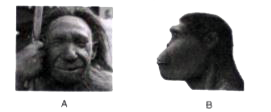Nutritionally Australopithecus was
carnivorous
omnivorous
herbivorous
none of these
The correct Answer is:C
Step-by-Step Text Solution:
1. Identify the Subject: The question is about the nutritional habits of Australopithecus, an early hominin species.
2. Historical Context: Australopithecus fossils were discovered in South Africa in 1924. The most notable find was the skull of a juvenile, known as the "Taung Child" or "Tong baby."
3. Classification of Nutritional Habits: To classify Australopithecus nutritionally, we need to consider what they consumed.
4. Analysis of Diet:
- Australopithecus is known to have had a varied diet.
- They were not strictly carnivorous (meat-eating) or herbivorous (plant-eating).
- Evidence suggests they consumed a mix of fruits, leaves, and possibly small animals, indicating they hunted and gathered.
5. Conclusion: Based on the evidence, Australopithecus is classified as omnivorous, meaning they consumed both plant and animal matter.
6. Final Answer: Therefore, nutritionally, Australopithecus was omnivorous.
---
- Australopithecus is known to have had a varied diet.
- They were not strictly carnivorous (meat-eating) or herbivorous (plant-eating).
- Evidence suggests they consumed a mix of fruits, leaves, and possibly small animals, indicating they hunted and gathered.
Topper's Solved these Questions
Similar Questions
The first fossil of Australopithecus was discovered in
View SolutionNutritionally Hydra is
View SolutionThe cranial capacity of Australopithecus was about 500 cc. Australopithecus existed in
View SolutionThe brain of Australopithecus measured
View SolutionGiven below are two stages in the evolution of man. Study them and answer the questions that follow :

(i) Identify Australopithecus and Neanderthal man from the above pictures.
(ii) Mention two characteristic features each for the two stages.
(iii) Who proposed the theory of Natural Selection?
(iv) Name the organism used as an example to explain 'Industrial Melanisum'.
(v) Give two examples of Vestigial organs in humans.
View SolutionRead the following statements about human evolution:
I. The skull of baby human is more like an adult chimpanzee skull than an adult human skull.
II. About two mya, Australopithecus probably lived in East African grassland.
III. The Neanderthal man with a brain size of 1400cc lived in the near East and Central Africa between 1,00,000-40,000 year back.
IV. Pre-historic cave art developed about 10,000 year ago.
How many statements is/are correct?
View SolutionChoose the correct statement w.r.t. Australopithecus africanus
View SolutionIn which part of the world did the early human ancestor Australopithecus appear about five million years ago.
View SolutionChoose the correct alternative :
Which one of the following is the most primitive ancestor of man?
1)Homo habilis
2)Australopithecus
3)Ramapithecus
4)Neanderthals
View SolutionFind out the correct pair.
(a) About 15 mya , Australopithecus were probably lived in African grassland and were essentially ate fruit.
(b) The first human like being the hominid was called Homo erectus with capacity 650 - 800cc.
(c) Between 1,00,00 - 40,00 years back, the Neanderthal man were evolved which were brain size of 1400cc.
(d) The skull of body human is more like adult chimpanzee skull than adult human skull.
View Solution
